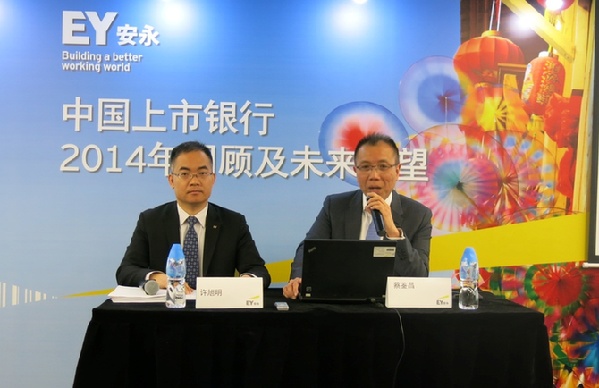EY: Listed banks see net profit slip in 2014
- By Guo Xiaohong
 0 Comment(s)
0 Comment(s) Print
Print E-mail China.org.cn, May 18, 2015
E-mail China.org.cn, May 18, 2015
|
|
|
Accounting firm Ernst & Young (EY) released its annual report, Listed banks in China - 2014 Review and Outlook, at a press conference in Beijing on May 12, 2014. Geoffrey Choi (right), assurance leader of EY Financial Services in Greater China, and Steven Xu, partner in Financial Services, EY, Greater China, at the EY conference. [Guo Xiaohong / China.org.cn] |
China's 21 A-share listed banks saw a continued slowdown in net profit growth in 2014, at an average pace of below 10 percent, the slowest growth in recent years, according to the report Listed banks in China - 2014 Review and Outlook, released by accounting firm Ernst & Young (EY) on May 12.
The net profits of the 21 banks totaled 1,283 trillion yuan, a 7.87 percent increase on 2013, but 5.06 percent lower growth than 12.93 percent in 2013.
"The decline in net profit growth was primarily due to rising non-performing loans," said Geoffrey Choi, assurance leader of EY Financial Services in Greater China at an EY press conference on May 12. The NPL (non-performing loans) ratio has been rising over the past two years. By 2014, NPLs of the 21 listed banks hit 674.8 billion yuan, 189.26 billion higher than in 2013.
Choi said banks have seen NPLs in more sectors. Apart from overcapacity in manufacturing, wholesale and retail industries, NPLs are also increasing in upstream and downstream industries involving commodity production like the coal and mining industries.
Besides the NPLs, China's prolonged macroeconomic slowdown is also an important factor, said Choi.
For the first quarter of 2015, net profit growth of the 16 A-share listed banks was dragged down by the macroeconomic slowdown. First quarter profit was 3.25 percent up, yet decreased by 8.59 percentage points compared with the same period in 2014.
Chinese listed banks have already begun to respond to the drag in earnings growth by accelerating organizational transformation and by making organizational adjustments, with the aim of boosting the profitability of business lines through improved operational efficiency and market responsiveness.
As to the challenge from the rapid development of Internet finance, China's traditional financial banks should hone their edge in order to compete for customers and funding, said Steven Xu, partner in Financial Services, EY, Greater China.
Online payment, small credit loans, and online investment products are three major businesses where Internet finance presents a challenge to traditional banking, said Xu, as customers are more prone to use Internet banking for its convenience, streamlined (simplified) service and more functionality.
In the last two years, China has witnessed many popular Internet financial products, which dilutes the flow of funds and customers to traditional banking, which is changing the way customers access financial products in China, tapping a broader and deeper market.
Yu'e Bao is one such example Launched by Alipay, an online payment company affiliated with Alibaba, China's largest ecommerce company, Yu'ebao has experienced a dazzling increase of customers because of its multi-functionality including higher interest rates, online payments and money transfer.
Around the beginning of 2014, Tencent, China's largest Internet service portal, also joined the market by launching an investment platform and the company promoted the platform during the Spring Festival in 2015 by allowing WeChat users to send each other "red packets (gift money)," a digital replacement for the traditional exchanges of gift money during the holiday.
In the face of this harsh competition, Steven Xu said that traditional banks should make innovations in developing e-banking platforms, developing more efficient mobile banking service and products while optimizing their network of physical outlets.
The annual report by EY was based on the financial disclosures of 19 listed banks on the Chinese mainland and in Hong Kong, including the Big Five state-owned banks, eight joint stock banks, five city-level commercial banks and one rural commercial bank.







Go to Forum >>0 Comment(s)